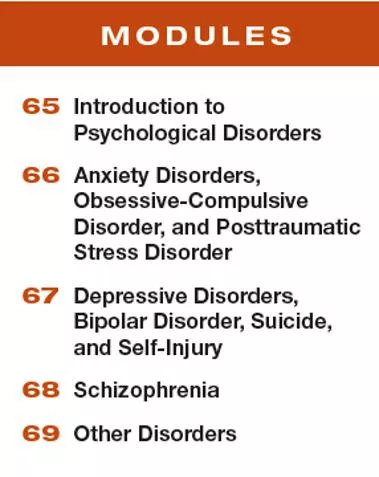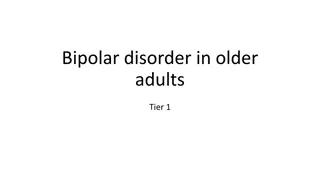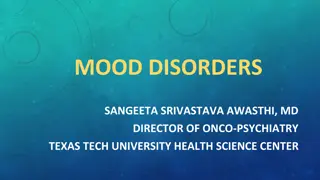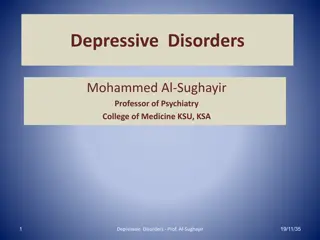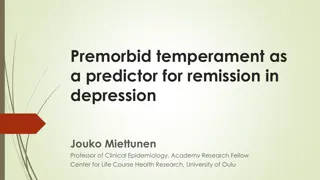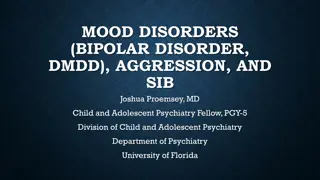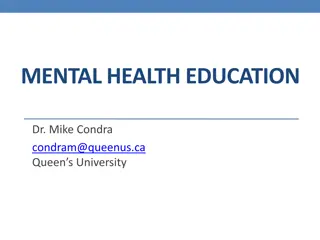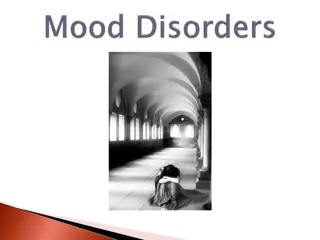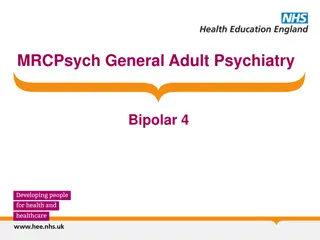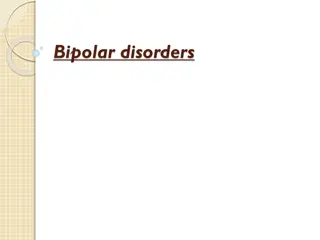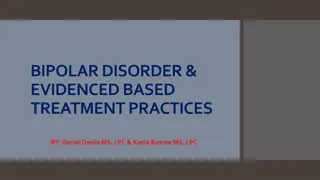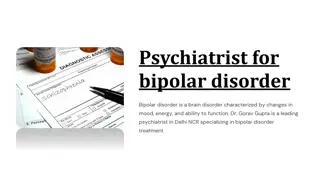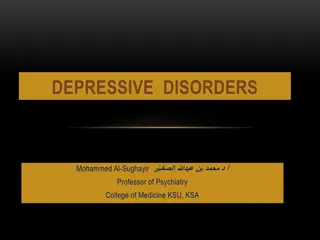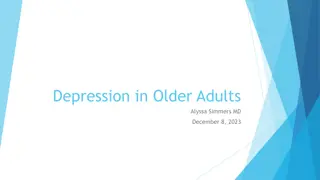Understanding Depressive Disorders and Bipolar Disorder
Depression is prevalent among students and individuals in the US. Major depressive disorder and persistent depressive disorder are characterized by varying degrees of depressive symptoms lasting for different durations. The diagnostic criteria include signs of depression persisting for specific periods. Factors like hopelessness, lethargy, decision-making difficulties, and concentration issues accompany these disorders. Understanding the distinctions and diagnostic processes for these conditions are crucial for effective management and support.
Download Presentation

Please find below an Image/Link to download the presentation.
The content on the website is provided AS IS for your information and personal use only. It may not be sold, licensed, or shared on other websites without obtaining consent from the author. Download presentation by click this link. If you encounter any issues during the download, it is possible that the publisher has removed the file from their server.
E N D
Presentation Transcript
Learning Targets 67-1 Contrast major depressive disorder, persistent depressive disorder, and bipolar disorder. Module 67 67-2 Analyze how the biological and social cognitive perspectives help us understand depressive disorders and bipolar disorder. Depressive Disorders, Bipolar Disorder, Suicide, and Self-Injury 67-3 Explain what factors increase the risk of suicide, and discuss what we know about non-suicidal self-injury.
How prevalent is depression? In the past year, have you at some time felt so depressed that it was difficult to function ? If so, you were not alone. In one national survey, 31 percent of American college students answered Yes. (ACHA, 2009) In a survey of American high school students, 29 percent felt so sad or hopeless almost every day for 2 or more weeks in a row that they stopped doing some usual activities. (CDC, 2008)
What is major depressive disorder? a state of hopelessness and lethargy lasting several weeks or months
How is major depressive disorder diagnosed? at least five signs of depression (including either depressed mood or loss of interest or pleasure) last two or more weeks
What is persistent depressive disorder? Persistent depressive disorder (also called dysthmia) is similar to major depressive disorder, but with milder depressive symptoms that last a much longer period of time.
Thinking critically Although your text uses this image in conjunction with the section on depression, how realistic do you feel it is? Have you known anyone who suffered from depression? Do they look this way? Some of the time? Not at all? Talk about it.
They also display at least two of the following symptoms: How is persistent depressive disorder diagnosed? Difficulty with decision making and concentration Feeling hopeless Poor self-esteem Reduced energy levels Problems regulating sleep Problems regulating appetite Adults diagnosed with persistent depressive disorder (also called dysthymia) have experienced a mildly depressed mood more often than not for two years or more. (American Psychiatric Association, 2013)
Have you cried today? When asked Have you cried today? Americans have reported doing so more often in the winter. For some people, depressive symptoms may have a seasonal pattern, returning each winter.
When a depressive episode ends, a euphoric, overly talkative, wildly energetic, and extremely optimistic state called mania follows. But before long, the mood either returns to normal or plunges again into depression. What is bipolar disorder? a disorder in which a person alternates between the hopelessness and lethargy of depression and the overexcited state of mania (Formerly called manic- depressive disorder.)
What does it feel like to suffer from bipolar disorder? In her art Life as a Two-Headed Beast: Bipolar, artist Abigail Southworth illustrated her personal experience of bipolar disorder.
What does research show about the manic phase of bipolar disorder? During the manic phase, people with bipolar disorder typically have little need for sleep. They show fewer sexual inhibitions. Their positive emotions persist abnormally. (Gruber, 2011; Gruber et al., 2013) Their speech is loud, flighty, and hard to interrupt. They find advice irritating. They need protection from their own poor judgment, which may lead to reckless spending or unsafe sex. Thinking fast feels good, but it also increases risk taking. (Chandler & Pronin, 2012; Pronin, 2013)
What is the relationship between bipolar disorder and creativity? In milder forms, mania s energy and flood of ideas can fuel creativity. Clusters of genes associated with high creativity increase the likelihood of having bipolar disorder, and risk factors for developing bipolar disorder predict greater creativity. (Baas et al., 2016; Power et al., 2015)
What does research show about the implications of bipolar disorder? Though bipolar disorder is much less common than major depressive disorder, it is more dysfunctional, claiming twice as many lost workdays early. (Kessler et al., 2006) Bipolar disorder is a potent predictor of suicide. (Schaffer et al., 2015) Americans are twice as likely as people of other countries to have ever had a diagnosis of bipolar disorder. (Merikangas et al., 2011)
What are biological explanations for major depressive disorder and bipolar disorder? genetic predispositions neurochemical imbalances nutritional deficits
What is the genetic factor? The risk of being diagnosed with major depressive disorder or bipolar disorder increases if your parent or sibling has the disorder. (Sullivan et al., 2000; Weissman et al., 2016) If one identical twin is diagnosed with major depressive disorder, the chances are about 1 in 2 that at some time the other twin will be, too. If one identical twin has bipolar disorder, the chances of a similar diagnosis for the co-twin are even higher 7 in 10 even for twins raised apart. (DiLalla et al., 1996)
1. What Would You Answer? The risk of bipolar disorder dramatically increases if you A. have suffered a debilitating injury. B. have an adoptive parent who has the disorder. C. have a biological parent with the disorder. D. have a life-threatening illness. E. have above-average intelligence.
What is the heritability of certain disorders? Using aggregated data from studies of identical and fraternal twins, researchers estimated the heritability of bipolar disorder, schizophrenia, anorexia nervosa, major depressive disorder, and generalized anxiety disorder. (Bienvenu et al., 2011)
Which brain structures play a role in depression and bipolar disorder? In people with bipolar disorder, studies discovered a decrease in myelinated axons and enlarged fluid-filled ventricles. (Arnone et al., 2009; Hibar et al., 2016) Depression can cause the brain s reward centers to become less active. (Miller et al., 2015; Stringaris et al., 2015) During positive emotions, the left frontal lobe and an adjacent reward center become more active. (Davidson et al., 2002; Robinson et al., 2012)
How is the brain changing during a manic episode? These top-facing PET scans show that brain energy consumption rises and falls with the patient s emotional switches. Red areas are where the brain rapidly consumes glucose.
2. What Would You Answer? Based on brain scans of those with bipolar disorder, which of the following is true? A. The brain is more active during manic episodes and less active during depressive episodes. B. The brain is less active during manic episodes and more active during depressive episodes. C. There is no consistent relationship between brain activity and periods of mania or depression. D. The brain is more active than normal during both manic and depressive episodes. E. The brain is less active than normal during both manic and depressive episodes.
How do neurotransmitter systems influence depressive disorders and bipolar disorder? Norepinephrine, which increases arousal and boosts mood, is scarce during depression and overabundant during mania. Serotonin is scarce or inactive during depression. (Carver et al., 2008) One study showed that depression is related to the combination of two factors significant life stress plus a variation of a serotonin-controlling gene. (Caspi et al., 2003; Moffitt et al., 2006)
How does physical exercise reduce depression? Repetitive physical exercise, such as jogging, reduces depression in part because it increases serotonin, which affects mood and arousal. (Airan et al., 2007; Ilardi, 2009; Jacobs, 1994) In one study, running for two hours increased brain activation in regions associated with euphoria. (Boecker et al., 2008)
3. What Would You Answer? During depression, researchers have found I. reduced levels of serotonin. II. reduced levels of norepinephrine. III. reduced activity in the hypothalamus. A. I only. B. II only. C. III only. D. I & II only. E. I & III only.
How can diet reduce depression? People who eat a heart-healthy Mediterranean diet (heavy on vegetables, fish, and olive oil) have a comparatively low risk of developing heart disease, stroke, late-life cognitive decline, and depression all of which are associated with inflammation. (Kaplan et al., 2015; Psaltopoulou et al., 2013; Rechenberg, 2016)
How can alcohol use and abuse lead to depression? Excessive alcohol use also correlates with depression, partly because depression can increase alcohol use but mostly because alcohol misuse leads to depression. (Fergusson et al., 2009)
How do life experiences play a role in depression and bipolar disorder? Diet, drugs, stress, and other environmental influences lay down epigenetic marks, molecular genetic tags that can turn certain genes on or off. Animal studies suggest that long-lasting epigenetic influences may play a role in depression. (Nestler, 2011)
How does the social-cognitive perspective explain depression and bipolar disorder? The social-cognitive perspective explores how people s assumptions and expectations influence what they perceive. Many depressed people view life through the dark glasses of low self-esteem. (Orth et al., 2016) Their intensely negative assumptions about themselves, their situation, and their future lead them to magnify bad experiences and minimize good ones. (Wenze et al., 2012)
How do our thoughts lead to depression? Expecting the worst, depressed people s self-defeating beliefs and their negative explanatory style feed their depression. Overthinking, or rumination, may also impact depression.
What is rumination? compulsive fretting; overthinking our problems and their causes Psychologist Susan Nolen-Hoeksema related women s higher risk of depression to what she described as their tendency to ruminate or overthink. Relentless, self-focused rumination can distract us, increase negative emotion, and disrupt daily activities (Johnson et al., 2016; Kircanski et al., 2015; Yang et al., 2017).
How does it apply to you? Have you ever been prone to rumination? About what do you ruminate? Share as a class.
How do social media comparisons factor into depression? When people scroll through social media feeds and see Maria having a blast with friends, Angelique enjoying a family vacation, and Tyra looking super in a swimsuit , the response, may be my life is terrible.
Think about The last time you did poorly or failed a test. How did you explain that to yourself? How did you answer the question Why did I do poorly on that test? Write down your thoughts.
What is explanatory style? Explanatory style who or what we blame for our failures seems to be similar for those suffering from depression.
What explanatory style seems common in those diagnosed with depression? Individuals diagnosed with depression often explain bad events in terms that are: stable ( It s going to last forever ) global ( It will affect everything I do ) internal ( It s all my fault ).
What does research show about explanatory style of people diagnosed with depression? Depression-prone people respond to bad events in an especially self-focused, self-blaming way. (Huang,2015; Mor & Winquist, 2002; Wood et al., 1990a,b). When people diagnosed with depression describe themselves, their brains show extra activity in a region that processes self-relevant information. (Sarsam et al., 2013) Individuals prone to depression have self-esteem that is more plastic it climbs with praise and plummets with threats. (Butler et al., 1994)
4. What Would You Answer? What term refers to thoughts about who or what we blame for our successes and failures? A. stability B. emotional memory C. the social-cognitive perspective D. explanatory style E. rumination
What is learned helplessness? the hopelessness and passive resignation an animal or person acquires when unable to avoid repeated aversive events
How might learned helplessness lead to depression? Self-defeating beliefs may arise from learned helplessness. Pessimistic, overgeneralized, self-blaming attributions may create a depressing sense of hopelessness (Abramson et al., 1989; Panzarella et al., 2006).
Why is depression more common among Western cultures? Psychologist Martin Seligman pointed to the rise of individualism and the decline of commitment to religion and family in Western, individualistic cultures In non-Western, collectivist cultures, where close-knit relationships and cooperation are the norm, major depressive disorder is less common and less tied to self-blame over personal failure. (Ferrari et al., 2013; WHO, 2004a)
How is depression a vicious cycle? Depression is both a cause and an effect of stressful experiences that disrupt our sense of who we are and why we are worthy human beings.
What are the pieces of the depression puzzle ? 1.Stressful experiences interpreted through 2. a ruminating, pessimistic explanatory style create 3.a hopeless, depressed state that 4. hampers the way the person thinks and acts. This, in turn, fuels further stressful experiences such as rejection.
What does research show regarding suicide? Each year over 800,000 despairing people worldwide will elect a permanent solution to what might have been a temporary problem. (WHO, 2014b) For those who have been anxious, the risk of suicide is tripled, and for those who have been depressed, the risk is quintupled. (Bostwick & Pankratz, 2000; Kanwar et al., 2013) People seldom commit suicide while in the depths of depression, when energy and initiative are lacking. The risk increases when they begin to rebound and become capable of following through. (Chu et al., 2016)
How do gender and age impact suicide? Women are much more likely than men to attempt suicide. (WHO, 2011) But men are two to four times more likely to actually end their lives. In late adulthood, suicide rates increase, with the highest rate among 45- to 64-year-olds and the second-highest among those 85 and older. (AFSP, 2015)
What are some factors that increase the risk of suicide? Men exposed to a family suicide were 8 times more likely to commit suicide than were non-exposed men. Gay, transgender, and gender nonconforming youth facing an unsupportive environment, including family or peer rejection, are also at increased risk of attempting suicide. (Goldfried, 2001; Haas et al., 2011; Hatzenbuehler, 2011; Testa et al., 2017) Following highly publicized suicides and TV programs featuring suicide, known suicides increase.
What factors may trigger suicidal urges? Suicidal urges typically arise when people feel disconnected from others and a burden to them, or when they feel defeated and trapped by an inescapable situation. (Joiner, 2010; Taylor et al., 2011) People especially older adults may choose death as an alternative to current or future suffering, a way to switch off unendurable pain and relieve a perceived burden on family members.
How can we help someone considering suicide? listen empathize and offer friendship involve the school psychologist or counselor, refer the person to the Suicide Prevention Lifeline or Crisis Text Line connect seek help from a trusted adult a parent, a teacher, a school nurse or school counselor or call 911 protect
What is nonsuicidal self-injury (NSSI)? Some people may engage in nonsuicidal self-injury (NSSI). Such behavior, though painful, is not fatal. Those who engage in NSSI may cut or burn their skin, hit themselves, insert objects under their nails or skin, or self-administer tattoos. Does NSSI lead to suicide? Usually not.
Who is most at risk for nonsuicidal self-injury? Self-injury rates peak higher for females than for males. (Data from CDC, 2009)
What does research show about people who engage in NSSI? People who engage in NSSI tend to experience bullying, harassment, and other life stress. (Liu et al., 2016; van Geel et al., 2015) They are generally less able to tolerate and regulate emotional distress. (Hamza et al., 2015) They are often extremely self-critical and struggle to communicate, solve problems, and perform academically. (Kiekens et al., 2016; Nock, 2010; You et al., 2015)



